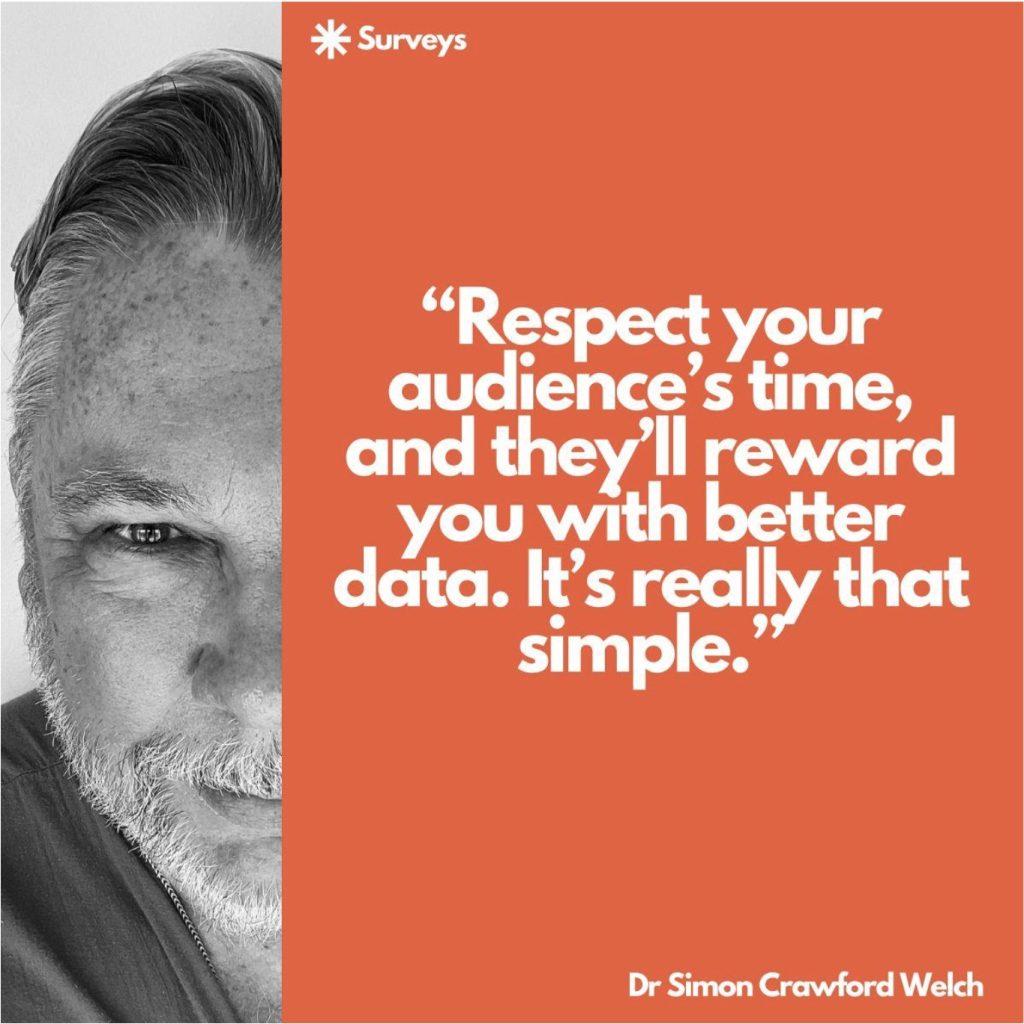By
Dr. Simon Crawford Welch

Let’s be honest: nobody wants to fill out a 20-question survey. Not your customers. Not your team. Not even your super-engaged fans. Long surveys are the digital equivalent of someone cornering you at a party with a clipboard and a list of “just a few quick questions” that turns into an interrogation.
In today’s fast-moving, attention-fractured world, the long-form survey is going extinct. And taking its place? The micro-survey – short, focused, and, dare I say, even enjoyable.
What Exactly Is a Micro-Survey?
A micro-survey is typically 1 to 5 questions, delivered at the right time, in the right context. It’s not meant to replace a deep-dive research study, but it is designed to give you reliable, actionable insights quickly. Think of it as the espresso shot of feedbac – small, strong, and just enough to keep your decisions moving forward.
You’ve probably interacted with a dozen of them without even noticing:
- A single question after a chat with customer service (“How did we do today?”)
- A 2-question pop-up after you check out on a website
- A 3-second pulse check in a company Slack channel
According to a study by SurveyMonkey, survey completion rates drop by up to 20% for every additional 5 questions added. When your survey has fewer than 5 questions? Completion rates can soar above 90%.
Why We’re Done With Long Surveys
There’s a massive shift happening in how organizations think about collecting data. Old-school surveys were built on the assumption that people had:
- Time,
- Patience,
- A desktop computer.
But it’s 2025. We’re reading emails while waiting in line. Scrolling while cooking. Living life in 15-second increments.
More importantly, respondent fatigue is real. Long surveys increase cognitive load, reduce accuracy, and encourage “satisficing” – when people give quick, easy answers instead of thoughtful ones just to get it over with. A paper published in Public Opinion Quarterly found that satisficing can lead to distorted data, particularly in the second half of longer surveys.
The kicker? Most of the value in survey responses comes from the first few questions. After that, drop-off in quality is steep.
What Makes Micro-Surveys So Powerful?
1. They Respect the User’s Time
There’s something deeply respectful about asking just one or two questions. It says, “We care about your opinion, and we don’t want to waste your time.” And in an age where trust is currency, that matters.
2. They Work Everywhere
Micro-surveys can be embedded in:
- Emails
- Texts
- Apps
- Slack
- Website widgets
- Even QR codes on product packaging
The flexibility is off the charts. And that means you can meet people where they are, without requiring them to click a separate link, enter a 10-digit code, and block out their lunch break.
3. They Enable Real-Time Feedback
Tools like Delighted, Hotjar, and Pendo are leading the way in real-time micro-survey tools. With integrations across platforms, companies can collect feedback the moment someone finishes a purchase, downloads a file, or speaks to customer support. This kind of in-the-moment feedback is far more accurate than asking someone to remember how they felt about an experience from two weeks ago.
4. They Build Habits
If you ask one thoughtful question each week – rather than a 20-question survey once a quarter—you create a rhythm. Employees get used to reflecting. Customers feel heard regularly. Over time, this feedback loop becomes a built-in part of your company culture.
In fact, software like Officevibe and Culture Amp offer weekly “pulse” surveys with 1-3 rotating questions. According to Culture Amp’s research, teams that consistently use micro-surveys see up to 27% higher engagement scores.
But Can They Go Deep?
The criticism of micro-surveys is fair: Can you really learn anything meaningful with just a question or two?
Here’s the secret: you don’t have to go deep every time. You just have to go deep over time.
The beauty of micro-surveys is that you can build a rolling dataset by asking targeted questions at different times to different segments. Instead of a one-shot blast, you’re gathering insight in layers – like painting a mural with hundreds of small brushstrokes.
Plus, AI-driven survey tools now analyze open-text responses in real time. So even a simple “Any other thoughts?” box can reveal themes, sentiments, and trending concerns with the right tools behind the scenes.
Real-World Example: Airbnb
Airbnb doesn’t ask you to fill out a long satisfaction survey when you leave a stay. Instead, they hit you with short, contextual questions:
- “How was the check-in experience?”
- “Did the listing match the photos?”
- “Would you stay here again?”
These questions are personalized, relevant, and take seconds. And yet, Airbnb collects millions of data points daily – all feeding into smarter recommendations, better host standards, and improved guest experiences.
Pro Tips for Designing Great Micro-Surveys
If you’re ready to ditch the bloated 20-question form, here are a few principles to design high-impact micro-surveys:
Be ruthlessly clear. No jargon. No ambiguity. Ask a direct question that takes 2 seconds to read.
Anchor to a moment. Ask when the experience is fresh – immediately after a transaction, a meeting, or an event.
Use smart branching. Tools like Typeform and Intercom let you tailor follow-ups based on previous answers – keeping things short and hyper-relevant.
Prioritize mobile-friendliness. Over 60% of surveys are now completed on mobile devices. If it’s not easy to tap through with one thumb, it’s too long.
Visualize the impact. Let people know their feedback matters. A thank-you message. A progress update. A summary in the next team meeting. Show them you’re listening.
The Bottom Line
The long-form survey isn’t dead – it’s just no longer your go-to tool for everyday insight.
Micro-surveys are changing the game. They’re fast. They’re nimble. They meet people where they are. And when done well, they provide richer, more honest data than surveys three times their length.
So the next time you’re tempted to fire off a 20-question “quick” survey – pause. Ask yourself: What’s the ONE thing I really need to know right now?
Then build a micro-survey around that. Your audience will thank you. And your data? It might just surprise you.
Simon Crawford-Welch, PhD, is the Founder, The Critical Thought Lab. Author of “American Chasms: Essays on the Divided States of America” & “The Wisdom of Pooh: Timeless Insights for Success & Happiness” (Available on Amazon) www.linkedin.com/in/simoncrawfordwelch



